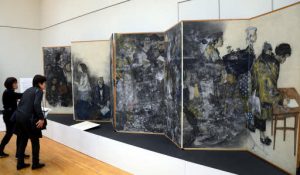Hiroshima Panels X “Petition” on display in Suginami, Tokyo, where antinuclear movement was born
Mar. 5, 2019
by Michiko Tanaka, Staff Writer
An exhibition of paintings by Iri and Toshi Maruki opened at Tokyo’s Suginami Social Education Center on March 4. The main work on display is the Hiroshima Panels X (ten) “Petition,” in which the late artists depicted the petition drive launched in the Suginami Ward to protest a hydrogen bomb test conducted by the United States at Bikini Atoll. The exhibition will continue until March 9.
This work, which came out in 1956, is part of a series of paintings called the Hiroshima Panels, which is the couple’s most famous work. The painting, which is 1.8 meters long and 7.2 meters wide and made on a folding screen, depicts the petition drive launched by local housewives and fishmongers, among others, propelled by their anger over the 1954 hydrogen bomb test, in which crew members of the Daigo Fukuryu Maru (The Lucky Dragon No. 5) fishing boat were exposed to radioactive fallout. The boat had left from its home port of Yaizu, Shizuoka Prefecture.
On the first day of the exhibition, Yukinori Okamura, 44, curator of the Maruki Gallery for the Hiroshima Panels in Higashi Matsuyama, Saitama Prefecture, offered explanations about the work to 60 visitors. He said that the artists wanted people to look toward a brighter future and depicted the power of the people who fought for their cause through non-violent means, adding that it was a historic painting which accurately shows the spirit of the times. Also on display is the Hiroshima Panels IX “Yaizu,” which depicts people waiting for the fishing boat to come back to its home port of Yaizu.
Michimasa Hirata, 83, who experienced the atomic bombing in Hiroshima at the age of 9, is a member of the exhibition’s executive committee which is composed of residents of the ward. He hopes that the exhibition will provide an opportunity for people to learn more about the antinuclear movement that spread from Suginami and think about what they can do to help create a better future. During the exhibition, A-bomb survivors will share their experiences each day, and a lecture on nuclear issues will be given.
(Originally published on March 5, 2019)
An exhibition of paintings by Iri and Toshi Maruki opened at Tokyo’s Suginami Social Education Center on March 4. The main work on display is the Hiroshima Panels X (ten) “Petition,” in which the late artists depicted the petition drive launched in the Suginami Ward to protest a hydrogen bomb test conducted by the United States at Bikini Atoll. The exhibition will continue until March 9.
This work, which came out in 1956, is part of a series of paintings called the Hiroshima Panels, which is the couple’s most famous work. The painting, which is 1.8 meters long and 7.2 meters wide and made on a folding screen, depicts the petition drive launched by local housewives and fishmongers, among others, propelled by their anger over the 1954 hydrogen bomb test, in which crew members of the Daigo Fukuryu Maru (The Lucky Dragon No. 5) fishing boat were exposed to radioactive fallout. The boat had left from its home port of Yaizu, Shizuoka Prefecture.
On the first day of the exhibition, Yukinori Okamura, 44, curator of the Maruki Gallery for the Hiroshima Panels in Higashi Matsuyama, Saitama Prefecture, offered explanations about the work to 60 visitors. He said that the artists wanted people to look toward a brighter future and depicted the power of the people who fought for their cause through non-violent means, adding that it was a historic painting which accurately shows the spirit of the times. Also on display is the Hiroshima Panels IX “Yaizu,” which depicts people waiting for the fishing boat to come back to its home port of Yaizu.
Michimasa Hirata, 83, who experienced the atomic bombing in Hiroshima at the age of 9, is a member of the exhibition’s executive committee which is composed of residents of the ward. He hopes that the exhibition will provide an opportunity for people to learn more about the antinuclear movement that spread from Suginami and think about what they can do to help create a better future. During the exhibition, A-bomb survivors will share their experiences each day, and a lecture on nuclear issues will be given.
(Originally published on March 5, 2019)








